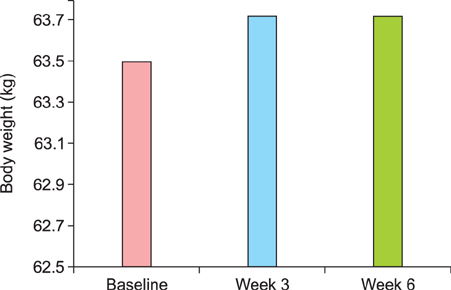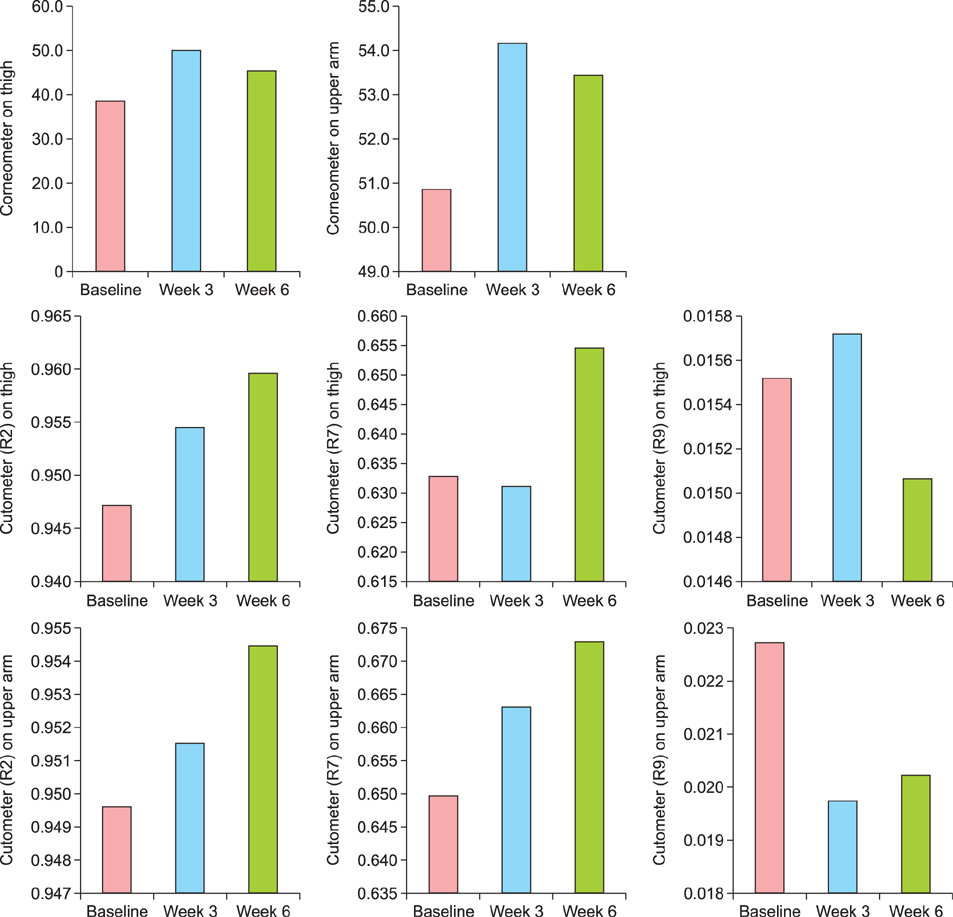Ann Dermatol.
2015 Jun;27(3):243-249. 10.5021/ad.2015.27.3.243.
Efficacy of Slimming Cream Containing 3.5% Water-Soluble Caffeine and Xanthenes for the Treatment of Cellulite: Clinical Study and Literature Review
- Affiliations
-
- 1Department of Dermatology, Seoul National University Bundang Hospital, Seoul National University College of Medicine, Seongnam, Korea. vividna@gmail.com
- 2Skin & Tech Incorporation, Seongnam, Korea.
- 3Soonchunhyang Medical Research Institute, Soonchunhyang University College of Medicine, Cheonan, Korea.
- KMID: 2352493
- DOI: http://doi.org/10.5021/ad.2015.27.3.243
Abstract
- BACKGROUND
Cellulite is a 'cottage cheese-like' cutaneous change caused by subcutaneous fat bulging into the dermis that usually leads to cosmetic problems. Slimming cream containing 3.5% water-soluble caffeine and xanthenes exhibits a lipolytic effect with penetration into the dermis.
OBJECTIVE
To evaluate the efficacy and safety of slimming cream for the treatment of cellulite.
METHODS
Fifteen subjects with cellulite applied slimming cream to the thighs and inner side of the upper arms twice daily for 6 weeks. Efficacy was assessed using a standard visual scale, changes in the circumferences of the thighs and upper arms, and patient satisfaction by a questionnaire at baseline, week 3, and week 6. Safety was assessed by inquiring about adverse events through questionnaires.
RESULTS
The standard visual scale score improved significantly by 0.49 points (19.8%) at week 6. Thigh and upper-arm circumferences decreased by 0.7 cm (1.7%) and 0.8 cm (2.3%), respectively, at week 6. Slight itching and transient flushing were commonly reported, but no serious adverse event occurred.
CONCLUSION
The slimming cream tested appears to be effective for the treatment of cellulitis without serious adverse effects. However, additional large clinical trials are required to confirm the efficacy and safety of slimming cream for the treatment of cellulitis.
Keyword
MeSH Terms
Figure
Reference
-
1. Cellulite meltdown? Harv Womens Health Watch. 1998; 5:7.2. Querleux B, Cornillon C, Jolivet O, Bittoun J. Anatomy and physiology of subcutaneous adipose tissue by in vivo magnetic resonance imaging and spectroscopy: relationships with sex and presence of cellulite. Skin Res Technol. 2002; 8:118–124.
Article3. Piérard GE, Nizet JL, Piérard-Franchimont C. Cellulite: from standing fat herniation to hypodermal stretch marks. Am J Dermatopathol. 2000; 22:34–37.4. Labat-Robert J. Age-dependent remodeling of connective tissue: role of fibronectin and laminin. Pathol Biol (Paris). 2003; 51:563–568.
Article5. Smalls LK, Hicks M, Passeretti D, Gersin K, Kitzmiller WJ, Bakhsh A, et al. Effect of weight loss on cellulite: gynoid lypodystrophy. Plast Reconstr Surg. 2006; 118:510–516.
Article6. Peters A, Schweiger U, Pellerin L, Hubold C, Oltmanns KM, Conrad M, et al. The selfish brain: competition for energy resources. Neurosci Biobehav Rev. 2004; 28:143–180.
Article7. Rawlings AV. Cellulite and its treatment. Int J Cosmet Sci. 2006; 28:175–190.
Article8. Dias M, Farinha A, Faustino E, Hadgraft J, Pais J, Toscano C. Topical delivery of caffeine from some commercial formulations. Int J Pharm. 1999; 182:41–47.
Article9. Bielfeldt S, Buttgereit P, Brandt M, Springmann G, Wilhelm KP. Non-invasive evaluation techniques to quantify the efficacy of cosmetic anti-cellulite products. Skin Res Technol. 2008; 14:336–346.
Article10. Smalls LK, Lee CY, Whitestone J, Kitzmiller WJ, Wickett RR, Visscher MO. Quantitative model of cellulite: three-dimensional skin surface topography, biophysical characterization, and relationship to human perception. J Cosmet Sci. 2005; 56:105–120.
Article11. Draelos ZD, Marenus KD. Cellulite. Etiology and purported treatment. Dermatol Surg. 1997; 23:1177–1181.
Article12. Diepvens K, Westerterp KR, Westerterp-Plantenga MS. Obesity and thermogenesis related to the consumption of caffeine, ephedrine, capsaicin, and green tea. Am J Physiol Regul Integr Comp Physiol. 2007; 292:R77–R85.
Article13. Cawthorn WP, Sethi JK. TNF-alpha and adipocyte biology. FEBS Lett. 2008; 582:117–131.14. Buscaglia DA, Conte ET. The treatment of cellulite with methylxanthine and herbal extract based cream: an ultrasonographic analysis. Cosmet Dermatol. 1996; 9:30–40.15. Hariya T, Sakai K, Shibata Mea. Proposal of a novel slimming theory (UCP theory) and development of slimming odorants. In : Proceedings 6th Scientific Conference of the Asian Society of Cosmetic Scientists; 2003. p. 207–220.16. Collis N, Elliot LA, Sharpe C, Sharpe DT. Cellulite treatment: a myth or reality: a prospective randomized, controlled trial of two therapies, endermologie and aminophylline cream. Plast Reconstr Surg. 1999; 104:1110–1114. discussion 1115-1117.
Article17. Kim C, Shim J, Han S, Chang I. The skin-permeation-enhancing effect of phosphatidylcholine: caffeine as a model active ingredient. J Cosmet Sci. 2002; 53:363–374.18. Trauer S, Patzelt A, Otberg N, Knorr F, Rozycki C, Balizs G, et al. Permeation of topically applied caffeine through human skin--a comparison of in vivo and in vitro data. Br J Clin Pharmacol. 2009; 68:181–186.
Article19. van de Sandt JJ, van Burgsteden JA, Cage S, Carmichael PL, Dick I, Kenyon S, et al. In vitro predictions of skin absorption of caffeine, testosterone, and benzoic acid: a multi-centre comparison study. Regul Toxicol Pharmacol. 2004; 39:271–281.
Article20. Alster TS, Tanzi EL. Cellulite treatment using a novel combination radiofrequency, infrared light, and mechanical tissue manipulation device. J Cosmet Laser Ther. 2005; 7:81–85.
Article21. Nootheti PK, Magpantay A, Yosowitz G, Calderon S, Goldman MP. A single center, randomized, comparative, prospective clinical study to determine the efficacy of the VelaSmooth system versus the Triactive system for the treatment of cellulite. Lasers Surg Med. 2006; 38:908–912.
Article22. Sasaki GH. Single treatment of grades II and III cellulite using a minimally invasive 1,440-nm pulsed Nd:YAG laser and side-firing fiber: an institutional review board-approved study with a 24-month follow-up period. Aesthetic Plast Surg. 2013; 37:1073–1089.
Article
- Full Text Links
- Actions
-
Cited
- CITED
-
- Close
- Share
- Similar articles
-
- A Pilot Study of Special Drug Delivering Fabric's Effect on Cellulite Reduction
- Survey of Caffeine Intake from Children's Favorite Foods
- Clinical Study of ZalsmingR on Xerosis and Pruritus
- A Case of Coffee Enema-induced Colitis
- Evaluation of Efficacy and Skin Irritation during Treatment of Nadifloxacin 1% Cream in Acne Vulgaris Patient






